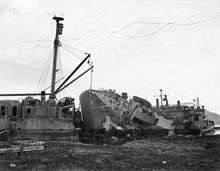USS Nestor (ARB-6)
 USS Nestor (ARB-6) at anchor. | |
| History | |
|---|---|
| Name: | USS Nestor |
| Namesake: | Nestor |
| Builder: | Chicago Bridge & Iron Company, Seneca, Illinois |
| Laid down: | 13 September 1943 |
| Launched: | 20 January 1944 |
| Commissioned: | 24 June 1944 |
| Decommissioned: | 29 November 1945 |
| Struck: | 3 January 1946 |
| Honors and awards: | 1 battle star (World War II) |
| Fate: |
|
| General characteristics | |
| Class and type: | Aristaeus-class battle damage repair ship |
| Displacement: |
|
| Length: | 328 ft (100 m) |
| Beam: | 50 ft (15 m) |
| Draft: | 11 ft 2 in (3.40 m) |
| Propulsion: | 2 × General Motors 12-567 diesel engines, two shafts, twin rudders |
| Speed: | 12 knots (22 km/h; 14 mph) |
| Complement: | 260 officers and enlisted men |
| Armament: |
|
USS Nestor (ARB-6) was one of twelve Aristaeus-class battle damage repair ships built for the United States Navy during World War II. Named for Nestor (in Greek mythology, the son of Neleus, the King of Pylos and Chloris), she was the only U.S. Naval vessel to bear the name.
Originally laid down as USS LST-518 on 13 September 1943 by the Chicago Bridge and Iron Company of Seneca, Illinois; launched sponsored by Miss Rita Jenkins; converted by Maryland Dry Dock Company of Baltimore, Maryland; and commissioned 24 June 1944 with Commander Frank W. Parsons, USNR, in command.
Service history
Designed to make emergency repairs in forward areas to battle-damaged ships, Nestor left Norfolk 4 August 1944 for Guantanamo Bay, the Panama Canal, and Ulithi, arriving 21 October to take up her primary mission. During the next five and a half months she acted as tender to small craft and repaired all types of naval vessels from battleships to LCIs.
Nestor left Ulithi 19 April 1945 for Kerama Retto, seized in the initial phase of the Okinawa campaign to serve as a base for the ships engaged in the main assault. Japanese air attacks, often by suicide plane, inflicted heavy damage on the fleet, and Nestor worked round-the-clock, often under fire her self, to help keep the fighting ships in action. As Okinawa itself became secure, Nestor entered Buckner Bay 10 July and continued her vital services, which here included the tremendous task of building a cofferdam. Nestor was driven aground by wind and heavy seas in the devastating Typhoon "Louise" of 9 October, and had to be abandoned. She decommissioned on 29 November, was stricken on 3 January 1946, and her hulk was sold for scrap on 1 May 1947.

In November 1945 the CNO directed that the hulk be sunk or destroyed, but this was not done and she became one of around 15 Okinawa typhoon wrecks that were finally sold for scrap in two batches in May and November 1947 by the State Department's Foreign Liquidations Commission. Nestor along with LST-823, LST-826, three floating docks, and some smaller craft, were included in the May batch and were purchased by the Oklahoma-Philippines Company in what was referred to as the "Berry sale". The date of her scrapping is not known.
Nestor earned one battle star for World War II service.
References
- This article incorporates text from the public domain Dictionary of American Naval Fighting Ships. The entry can be found here.
- "LST-518 / ARB-6 Nestor". Service Ship Photo Archive. Retrieved 7 April 2007.